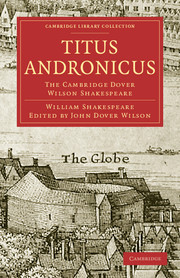THE COPY FOR TITUS ANDRONICUS, 1594, 1600, and 1623
Published online by Cambridge University Press: 07 September 2010
Summary
The text of Q1 and Q2
‘There can be little doubt’, writes Greg, that Q1 ‘was printed from the author's copy’, and he notes at the same time that its stage-directions ‘are descriptive and literary, very much what we should expect from an author not closely connected with the theatre’. This means that the manuscript sold to Danter for printing early in February 1594 was probably what is known as the ‘foul papers’, i.e. the author's draft from which the theatre prompt-book was prepared. The point about the literary stage-directions is interesting in view of the claim for Peel's authorship of the original play, but they are by no means confined to the first act, and the same type of direction is commonly found in Shakespeare's plays at this early period. May it not, therefore, point to a lack of close connexion between author and company? If Shakespeare was not accustomed to write for the Earl of Sussex's men he would naturally desire that his intentions should be unmistakable. We have seen above that the manuscript had undergone expansion, and that the three and a half lines left standing by inadvertence at 1. 1. 35 are strongly suggestive that at any rate in Act 1 what Danter printed was the original MS. plus Peel's additions.
- Type
- Chapter
- Information
- Titus AndronicusThe Cambridge Dover Wilson Shakespeare, pp. 91 - 97Publisher: Cambridge University PressPrint publication year: 2009First published in: 1948

